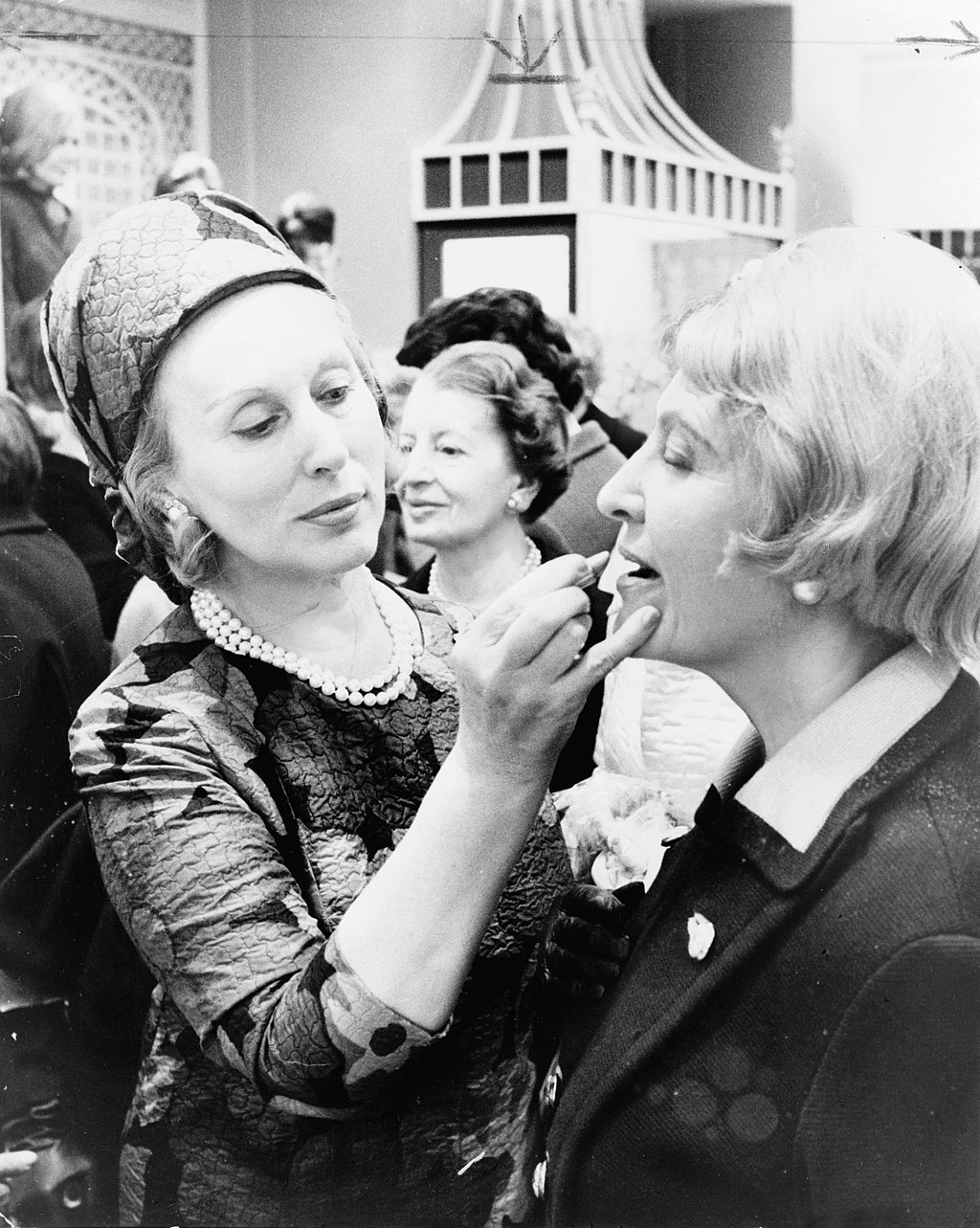Fair or Foul (1946)
Hamlet railed at Ophelia, “God has given you one face and you make yourselves another.” Although the Prince of Denmark was anti the art of makeup- what he viewed as female duplicity- the modern day woman who became Estée called cosmetics, “jars of hope.” She pronounced there were no ugly women, just lazy ones.
James Gatz reinvented himself as Jay Gatsby in an attempt to divorce himself from his past, and Josephine Esther Mentzer, who hailed from Queens, used the same ploy. She was one of six children of Jewish, East European immigrants, and she and her family lived above her father’s hardware store. A source of perpetual embarrassment was her parents’ thick accents and foreign ways, which set her apart in her mainly Italian neighborhood. She imbibed a love of fashion from her mother, Rose, who always wore gloves; from her father, Max, she learned how to attract customers. During the Christmas season, in a nod to promotion, he gave away gifts of hammers and nails.
An even greater influence on Josephine’s life was her Uncle John Schotz, who joined the family when he emigrated from Hungary during World War I. He had been trained as a chemist and concocted cosmetics on the family stove. His feisty niece was his designated saleswoman, and her first customers were friends from Newtown High School who she brought home to try his beauty creams. She later recalled, “I was forever experimenting on myself and on anyone who came in range.” Before graduation she bid farewell to high school and entered the beauty business armed with her uncle’s products, her own flawless complexion, and an unquenchable thirst to succeed.
At first Josephine took the novel tactic of peddling her wares to small beauty salons in her neighborhood. Emboldened, she made her way to the House of Ash Blondes on the Upper West Side. She proved such a dynamic salesperson that its proprietor hired her to run the beauty counter at a new branch. Josephine applied her potions as her customers sat captive under huge metal hair dryers. When their hair was done, Josephine removed the cream and made up the women’s faces with her limited selection of home-brewed products. The repertoire included one turquoise eye shadow and one lipstick shade called Duchess Crimson (named after America’s fashion idol of the day, the Duchess of Windsor). In most instances, customers would leave with one purchase and one free sample, a nod to Mr. Mentzer’s Christmas promotions.
As a teenager Josephine met Joseph Lauter, whose Jewish parents had emigrated from Austria, and the couple wed in 1930. Three years later they had son Leonard Allen, but the birth did not prove to be a salve to marital troubles. In 1939, Josephine obtained a divorce and moved to Florida, where she purportedly had an affair with a married fragrance industry executive. Years later she explained, “I was married very young. You think you missed something out of life. But I found out that I had the sweetest husband in the world.” The couple remarried in 1942, and henceforth she referred to their relationship as one of the greatest love stories of all time. Their son Ronald arrived two years later.
Joseph gave up his own business venture which had not proved lucrative, and the couple joined forces. Josephine’s parents had called her Esty after her middle name, Esther, and she decided to christen the company Estée- the accent mark was to associate it with European exotic. Joseph’s family name had originally been “Lauder,” but an immigration officer had inadvertently altered its spelling. They decided to revert to its original to honor their heritage. Paradoxically, while reclaiming Joseph’s history, Estée embellished her own. She claimed to have been raised in a Hapsburg castle, and she described her father as “an elegant, dapper monarchist from Europe.” This comment was quite a reinvention for the hardware store owner from Queens, though this borough’s name (at least) did smack of royalty.
They only had a handful of products and for distinction they packaged them in a case of greenish blue. Estée, a name which she used personally as well as professionally, went on the road to induce finer stores to feature her merchandise. She would tempt prospective clients with her pitch, “Time is not on your side, but I am!” The greatest coup came when Saks Fifth Avenue agreed to carry her products; it was where the “ladies who lunched” shopped, where customers had the means to say the three most beautiful words in retail: “Charge it please.” Estée and Joseph quickly cooked up the creams in their “factory,” a converted restaurant, and in two days, Saks sold out. Word spread of the woman who delivered what Ponce de Léon had sought, and soon she was selling to prestigious stores. With her chutzpah and schmoozing, her wares took wing- but interspersed with success there was a painful episode. She was at a salon in New York where she admired the blouse of an elegant customer and inquired where it had been purchased. The woman replied, “What difference could it possibly make? You could never afford it.”
The Lauders hit the jackpot when they marketed a bath oil aimed at the typical matron who could not purchase expensive French perfume. Youth Dew carried a price tag of $8.50, and it catapulted the modest business into the big league. It took the company from a sales volume of $400 to around $5,000 a week. Encouraged when Harrods  in London agreed to sell her wares, she was dismayed, but not deterred, when a high-end French shop would not allow Estée Lauder on its hallowed shelves. In response Estée arranged for Youth Dew to spill onto its floor. The inquiries from shoppers concerning the aroma resulted in the blue-green packages receiving a coveted spot. Another stroke of good fortune was Estée’s novel practice of giving away free samples and for instituting the concept of “gift with purchase.” The ploy became a cosmetic counter staple. When the tactic worked, she sent freebies to high profile women. Princess Grace of Monaco told an interviewer, “Mrs. Lauder is such a nice person. She keeps sending all these things.”
in London agreed to sell her wares, she was dismayed, but not deterred, when a high-end French shop would not allow Estée Lauder on its hallowed shelves. In response Estée arranged for Youth Dew to spill onto its floor. The inquiries from shoppers concerning the aroma resulted in the blue-green packages receiving a coveted spot. Another stroke of good fortune was Estée’s novel practice of giving away free samples and for instituting the concept of “gift with purchase.” The ploy became a cosmetic counter staple. When the tactic worked, she sent freebies to high profile women. Princess Grace of Monaco told an interviewer, “Mrs. Lauder is such a nice person. She keeps sending all these things.”
With Estée ensconced as the doyenne of beauty, she took photographs with the rich and famous: Princess Diana, Nancy Reagan, Princess Grace, and Begum Aga Khan. One of her most cherished photographs, of an American divorcee whose wiles had lured a king from his throne, bore the words, “To Estée, with afection, Wallis, Duchess of Windsor.” Whatever wiles Wallis used to lure a king from his throne and impress a cosmetics queen, it was not superb spelling.
With Estée Lauder dominating the beauty industry, its eponymous founder became part of the rich and famous. This feat was partially due to her company’s auxiliary lines: Clinique, Origins, Prescriptives, Aramis, and MAC. With a many-splendored bank account, the girl who grew up over a hardware store accumulated homes as other women did charms on a bracelet: Upper East Side townhouse, Manhattan office with view of Central Park, oceanfront estate in Palm Beach, London flat, and a villa in the South of France. The fashion horse was always immaculately turned out-five feet four inches of tooth and claw-in Paris couturier, often Chanel, purchased six at a time. In 1982, she flexed her economic muscle. Feeling that her ruby and diamond tiara clashed with her turquoise dress, she switched to a gold and diamond crown.
When she passed the torches to her sons-the Kennedys of the beauty world- she left them a legacy of billions. Ronald garnered media attention when he purchased the painting of Adele Bloch-Bauer, Klimpt’s famous Woman in Gold. The Viennese Mona Lisa had graced the walls of Austria’s Belvedere Museum for over a half century, and now resides in Lauder’s Manhattan East Side gallery after he purchased it for $135 million. He stated of the gold-flecked masterpiece, “In World War II there were very few happy endings; this is one of them.” Another coup of which Ms. Lauder would have been proud is when her daughter-in-law Evelyn, Leonard’s wife, an Austrian immigrant who had fled the Nazis, originated the symbol of the pink ribbon for breast awareness.
Ms. Lauder, though solicitous of friends, was not above using her lacquered nails as talons against her opponents. She referred to Charles Revson (of Revlon fame) as “My arch and implacable enemy,” and that Elizabeth Arden was, “not a nice woman, not a generous woman,” and commented that although Helena Rubenstein may have looked like a czarina, “the skin on her neck was less than perfect.”
Estée’s detractors could be equally lethal. Lee Israel, in his unauthorized biography, Estée Lauder: Beyond the Magic, showed an ugly side of the dowager of beauty. He wrote that although she was fabulously wealthy, her Uncle John Schotz died in dire straits. He also blamed her for downplaying her Judaism, and he cited an interview where she claimed she was half Italian and convent -bred. Israel levied the criticism she was a name-dropper, a social-climber, and a user. He quoted an ex-secretary of the Duchess of Windsor who claimed that after the passing of the Duke, with the duchess shunned and infirm, Mrs. Lauder proved to be a turncoat-albeit one with a designer label. And there was a mention that the Hapsburg castle of her childhood had been located over a hardware store.
It is impossible to know whether the dowager of beauty’s mirror reflected the fairest or the foulest of them all. The only truth we can glean is the girl from Queens, through overweening grit, became the tiara-wearing queen of a cosmetics empire.


